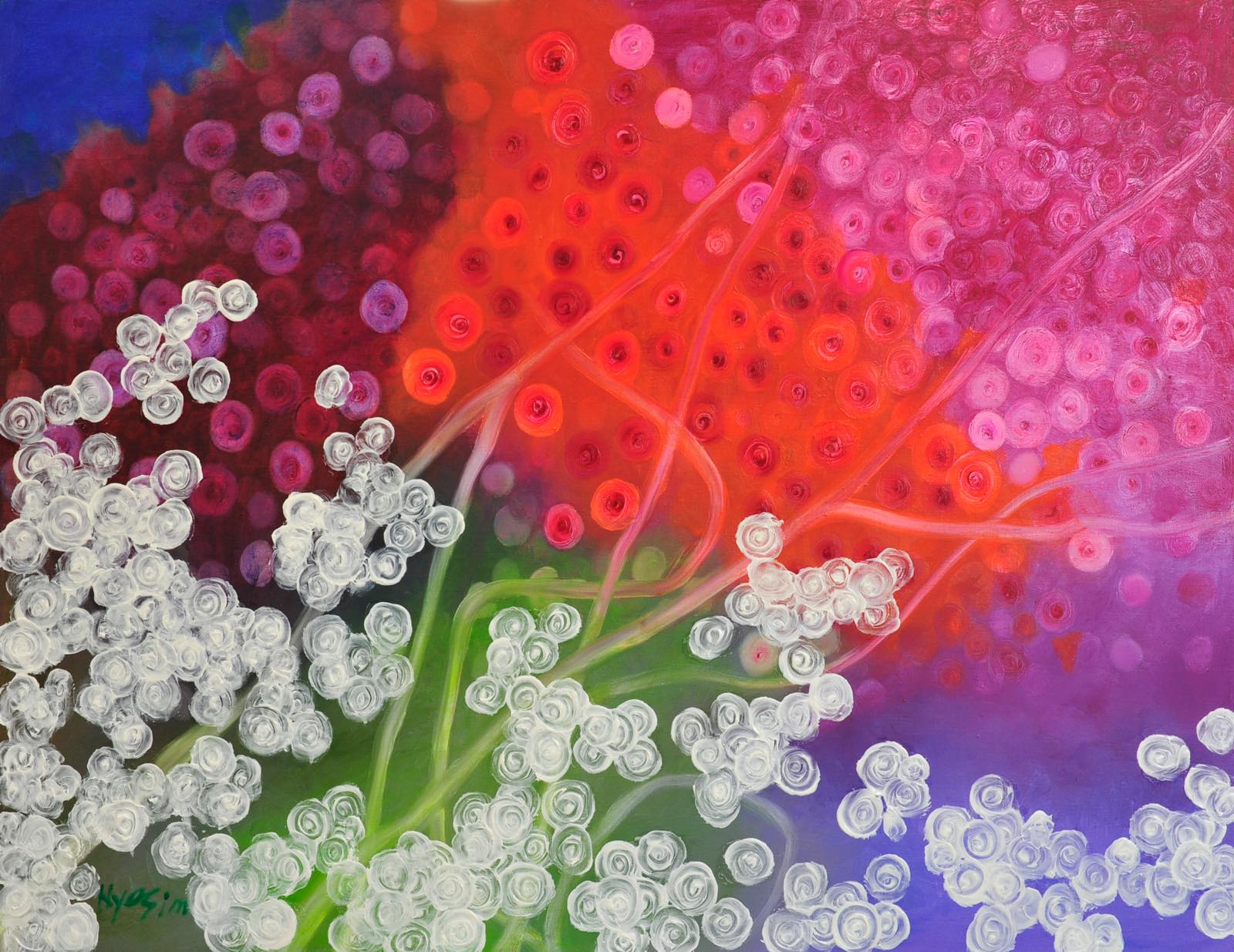Home > Archive
‘Love’ of Choi Hyesim
A Fantastic, Transcendental & Mysterious Formative Language
Shin Hang-Seop (Art Critic)
Painting not only praises realistic beauty but pursues imaginary, fantastic or unrealistic beauty. Formative imagination of a painter may be said as an eventual effort for making the world beautiful. Through creating the world invisible in the reality, a space of the real is expanded to that of the imaginary. So, we come to experience the world different from the reality through painting. In the end, painting projects a painter’s individual view of a life so her subjective perspective is bound to be acted on. Such a subjective perspective is the very source of creation.
Choi Hyesim makes a unique formative space that painting and a written language coexist with each other. Painting and characters come together naturally as a body. Maybe it reminds us of a ‘hidden picture’. There exist characters certainly but we can’t know their existence without detailed examination. It is a formative technique and a formative idea combining a seemingly ill-matched relation between characters and realistic images elaborately is so fresh.
Characters appeared in her painting contain a Hangeul word ‘Love’. A word ‘Love’ is changed into various forms and merged into the painting naturally. So to speak, a Hangeul word ‘Love’ comes to have a pictorial form like hieroglyphic Chinese characters. Hieroglyphic Chinese characters can be transformed into a picture if disassembled but Hangeul of phonogram has nothing to do with a shape from the outset. However, she enjoys a formative magic changing Hangeul to parts of the painting.
Everywhere in her works, characters ‘Love’ exist. However, it doesn’t claim its independent status as characters, changing to images of a tree, flower or person in the scenery and placing itself as a hidden shape scarcely to be seen. A magic happens, expressing images of a flower, fruit, person or cloud as characters of ‘Love’. However, it is neither strange nor unpleasant to the eye. Since, it is formed as part of natural objects. It is her own formative idea unimaginable to everyone. Maybe she could well embody characters ‘Love’ into the painting while working on a method for conveying the meaning of the word ‘Love’ as it is.
A word ‘Love’ makes persons feel comfortable and warm. Also it evokes happy and pleasant feelings. For even the most wicked man, love has the power to dissolve evil feelings completely. A word ‘Love’ inducing feelings of dream, hope, happiness and romance is beyond description only excepting the really mysterious one. The reason why she puts a written language ‘Love’ into the work directly is that she believes in such a mysterious power.
Setting ‘Love’ as a theme of working may be said as the natural selection by a painter who contributes to making the world beautiful. Love refers to broad catholicity to understand, forgive and embracing each other with reconciliation. She aims at making the world utopia by embodying such a power of love. As such, her painting changes the magical power of love into a visual image. Light, clear, pure and beautiful materials and color images occupy a dominant position. It is impossible to have bad feelings while seeing such a picture.
As shown from the word ‘Love’, her works are full of visual pleasure. Visual aesthetics not only from materials but from color images corresponds to wide-ranging meanings of ‘Love’. Maybe the reason why she embodies characters ‘Love’ as the painting is that she believes that love is the absolute power to make the world utopia. It has something to do with contents of the painting. Meaning a written language has may be connected to contents of the painting. In such a sense, her working transforming characters ‘Love’ into a formative image is equipped with contents of itself.
In her works, characters don’t claim independent forms and meanings. Instead, they are positioned under the pretext of a shape or via assimilation with it. It is a situation characters come to be hidden or merged into a shape. Though engaged in the pictorial form, characters have more significant meanings as contents. In other words, they take a key role to lead and dominate a message painting conveys, or contents in the works. For instance, a few people gather together, and if seen in detail, every figure takes a role of a consonant or a vowel, completing characters ‘Love’. However, while seeing such people, it is not easy to read characters ‘Love’ immediately. Since they are concealed, hidden and transformed into a shape of a person.
Her works sometimes show a characteristic of all-over painting. Small fruits cover the entire canvas. There, innumerable human characters also exist. Stems of a fruit have consonants and vowels forming characters ‘Love’. Characters ‘Love’ are positioned as a recluse even in the ocean or universe images in addition to a dancing woman or a utopian landscape full of flowers and fruits.
In some regards, her working may be said as a form to integrate painting describing forms of existent objects with literature describing in a written language into a single perspective. So, some works have deep lyrical beauty. They are literary works not because of contained characters but because of the overall feelings of the work. Lyricism of literature and painting arouses feelings of dream, love, happiness and romance. Lyricism expressed in her works coexists with fantastic, surrealistic and mysterious images. Therefore, it creates visual beauty different from that of the real world.
– Published in Art & Criticism –





